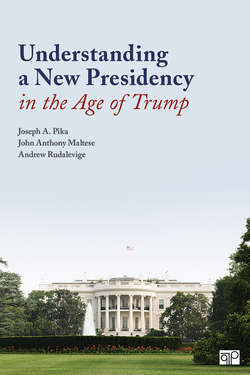Читать книгу Understanding a New Presidency in the Age of Trump - Joseph A. Pika - Страница 10
На сайте Литреса книга снята с продажи.
III. The First Hundred Days
ОглавлениеFranklin Delano Roosevelt set a standard during his first hundred days in office that is hard to beat. When he was sworn in during the midst of the Great Depression on March 4, 1933, some wondered if American democracy would survive. The stock market had collapsed, banks had failed, unemployment had reached 25 percent, and the fear of public unrest was such that machine guns guarded government buildings.41 Nonetheless, Roosevelt embraced optimism, called for action, and rallied the spirit of a downtrodden people. Asserting that “the only thing we have to fear is fear itself,” he called Congress into a special emergency session and promised to “recommend the measures that a stricken nation in the midst of a stricken world may require.”42 That special session lasted three months, and people referred to it as the “hundred days.”
The 1932 elections gave Roosevelt a powerful edge by sweeping into power an overwhelming majority of fellow Democrats in both the Senate (fifty-nine Democrats, thirty-six Republicans, and one other) and the House of Representatives (313 Democrats, 117 Republicans, and five others). Those hundred days produced seventy-six pieces of legislation, including fifteen major bills that greatly expanded the size of the federal government through the creation of, among other things, the Federal Deposit Insurance Corporation to protect bank accounts, the Public Works Administration to provide jobs, and the National Industrial Recovery Act to regulate industry and stimulate the economy. Roosevelt touted the success of “the hundred days” in one of his Fireside Chats—thereby establishing a yardstick of success that has been used to measure the accomplishments of all subsequent presidents.43
As his own hundred days wound down, President Trump declared such a yardstick to be a “ridiculous standard.”44 Certainly it is an arbitrary one. Like any snapshot, it captures a particular period in time—one which, by definition, does not reflect a president’s later successes or failures. In fact, the vast majority of presidents since FDR have not secured passage of landmark legislation during their first hundred days, even if the period is marked by a flurry of other legislative action that lays the groundwork for achievement.45 For example, Ronald Reagan signed into law the historic 1981 tax cuts in August—after the conclusion of his first hundred days. Likewise, Congress passed George W. Bush’s tax cut proposal in June 2001 and his landmark education measure, “No Child Left Behind,” in mid-December of that year. The Affordable Care Act (“Obamacare”) became law in March 2010. That is why, at the end of Trump’s first hundred days, House Speaker Paul Ryan (R-WI) suggested that judging the president at the end of the second hundred days might be a better measure. As Ryan put it, “the kind of agenda that we’re attempting to put together here—overhauling health care, overhauling the tax system, rebuilding our military, securing our border—those take more than just a few months.”46 In Trump’s case, though, the second hundred days also came and went with no major legislation enacted or clearly in process.
Whether the first hundred days are a truly representative forecast of things to come, assessing new presidents within that timeframe is nonetheless appropriate. A president’s patterns of decision-making and his policy templates are set early—if not set in stone—and the first impressions of “Washingtonians,” as well as the wider public, are hard to shake. Indeed, the focus on the first hundred days reflects a maxim that most presidential observers agree upon: it is important for new administrations to hit the ground running. As political scientist James P. Pfiffner explains, presidents “want to take advantage of the ‘mandate’ from the voters and create a ‘honeymoon’ with Congress.” Early victories in implementing their policy goals may provide momentum for additional victories. “This desire to move fast is driven by the awareness that power is fleeting.”47
Donald Trump, as a candidate, himself set a specific marker for early accomplishment. In a signed “contract with the American voter” released in October 2016, Trump said that “on November 8, Americans will be voting for this 100-day plan” comprised of administrative, legislative, and even constitutional change. Some of the actions, the contract said, would be pursued “on the first day of my term of office.”48
As president, Trump continued to tout his achievements in the context of a short temporal window. At a campaign-style rally in Nashville, Tennessee in mid-March 2017, he claimed that “we have done far more, I think maybe more than anybody’s done in this office in 50 days. That I can tell you.” A month later, in Kenosha, Wisconsin, he told a crowd that “no administration has accomplished more in the first 90 days.” He offered a similar tribute relative to the standard landmark: “I truly believe that the first 100 days of my administration has been just about the most successful in our country’s history.”49
In light of these promises and claims, it is worth reviewing the actions and achievements of the new administration during the first hundred days—tracking the legislative, administrative, and public presidencies.
